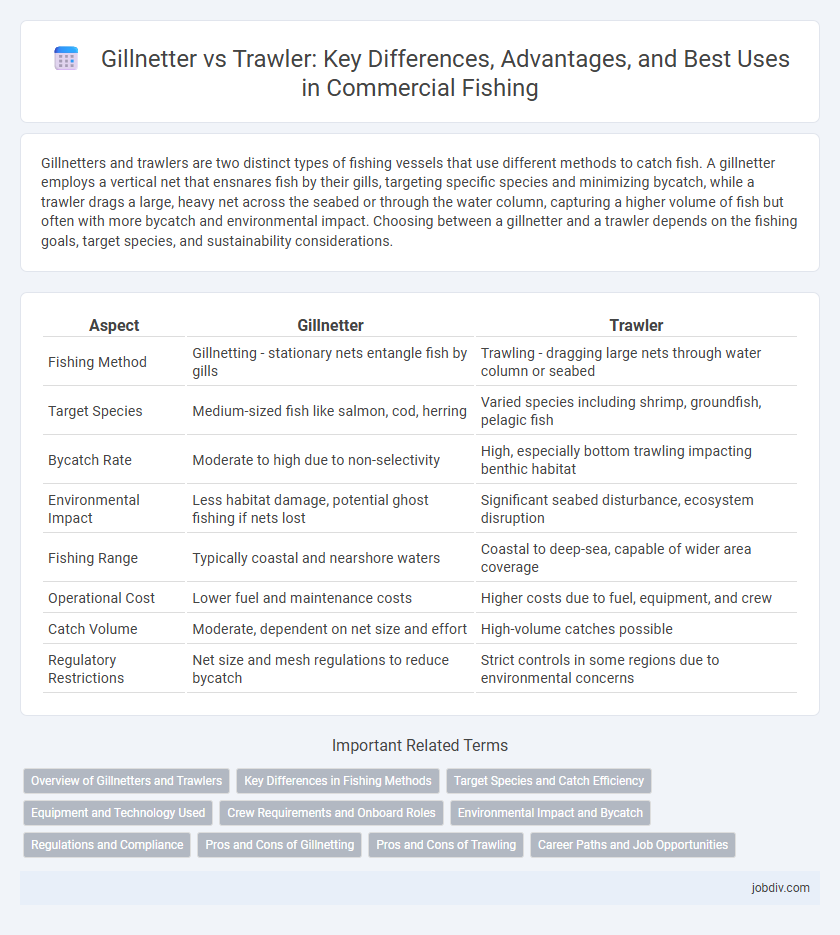Gillnetters and trawlers are two distinct types of fishing vessels that use different methods to catch fish. A gillnetter employs a vertical net that ensnares fish by their gills, targeting specific species and minimizing bycatch, while a trawler drags a large, heavy net across the seabed or through the water column, capturing a higher volume of fish but often with more bycatch and environmental impact. Choosing between a gillnetter and a trawler depends on the fishing goals, target species, and sustainability considerations.
Table of Comparison
| Aspect | Gillnetter | Trawler |
|---|---|---|
| Fishing Method | Gillnetting - stationary nets entangle fish by gills | Trawling - dragging large nets through water column or seabed |
| Target Species | Medium-sized fish like salmon, cod, herring | Varied species including shrimp, groundfish, pelagic fish |
| Bycatch Rate | Moderate to high due to non-selectivity | High, especially bottom trawling impacting benthic habitat |
| Environmental Impact | Less habitat damage, potential ghost fishing if nets lost | Significant seabed disturbance, ecosystem disruption |
| Fishing Range | Typically coastal and nearshore waters | Coastal to deep-sea, capable of wider area coverage |
| Operational Cost | Lower fuel and maintenance costs | Higher costs due to fuel, equipment, and crew |
| Catch Volume | Moderate, dependent on net size and effort | High-volume catches possible |
| Regulatory Restrictions | Net size and mesh regulations to reduce bycatch | Strict controls in some regions due to environmental concerns |
Overview of Gillnetters and Trawlers
Gillnetters use vertical panels of netting designed to entangle fish by their gills, making them highly selective for species and sizes, and minimizing bycatch compared to other methods. Trawlers drag large nets either along the sea floor or through midwater to capture a wide range of fish and shellfish, resulting in higher volume catches but increased bycatch and habitat disturbance. The choice between gillnetters and trawlers often depends on targeted species, environmental regulations, and fishing efficiency requirements.
Key Differences in Fishing Methods
Gillnetters use stationary nets set vertically in the water column to entangle fish by their gills, targeting specific sizes and species with minimal habitat disturbance. Trawlers drag large, weighted nets across the seafloor or midwater to catch a wide variety of fish, often resulting in higher bycatch and greater environmental impact. The precision of gillnetting contrasts with the broad, non-selective capture method of trawling, influencing sustainability and fishery management practices.
Target Species and Catch Efficiency
Gillnetters primarily target species like salmon, cod, and herring by using vertically hanging nets that entangle fish by their gills, ensuring selective harvesting with minimal bycatch. Trawlers, equipped with large cone-shaped nets dragged along the sea floor or midwater, effectively capture diverse species such as shrimp, pollock, and groundfish but often result in higher bycatch rates and habitat disturbance. Catch efficiency of gillnetters is optimized for specific species and sizes, while trawlers boast higher volume catches but lower species selectivity, impacting sustainability considerations in fishing practices.
Equipment and Technology Used
Gillnetters use vertical panels of netting with specific mesh sizes designed to entangle fish by their gills, often equipped with GPS and sonar for precise placement. Trawlers deploy large, cone-shaped nets dragged along the sea floor or midwater, utilizing advanced winching systems and powerful engines to maintain speed and control. Both employ electronic fish finders and navigation systems, but trawlers typically incorporate more robust technology due to the scale and depth of their operations.
Crew Requirements and Onboard Roles
Gillnetter fishing vessels typically require smaller crews, often between 3 to 5 members, due to the more manual and stationary nature of handling gillnets. In contrast, trawlers demand larger crews, ranging from 6 to 15 or more, to operate complex machinery, manage heavy nets, and process the catch onboard. Crew roles on gillnetters prioritize net deployment and retrieval, while trawler crews include specialized positions such as engineers, deckhands, and fish processors to manage extensive operations.
Environmental Impact and Bycatch
Gillnetters use stationary nets that can result in high bycatch rates, including endangered marine species, causing significant ecological disruptions. Trawlers drag large nets along the seafloor, often damaging benthic habitats and resulting in substantial bycatch of non-target species such as juvenile fish and seabed organisms. Both methods pose environmental challenges, but trawling generally causes greater habitat destruction, while gillnetting's selective nature still leads to notable bycatch concerns.
Regulations and Compliance
Gillnetters face strict regulations on mesh size and net length to protect juvenile fish and minimize bycatch, enforced by agencies like NOAA and the EU Fisheries Council. Trawlers must comply with vessel monitoring systems, seasonal closures, and bycatch reduction devices mandated under regional fisheries management organizations. Both gear types operate under quota limits and reporting requirements to ensure sustainable fishing practices and legal compliance.
Pros and Cons of Gillnetting
Gillnetting offers selective fishing with minimal fuel consumption, reducing environmental impact compared to trawling, which uses large nets dragged along the sea floor. However, gillnets often cause bycatch and can entangle marine mammals and turtles, posing ecological risks. The method is cost-effective for small-scale fisheries but less efficient for high-volume catches relative to trawling.
Pros and Cons of Trawling
Trawling offers high efficiency in capturing large volumes of fish, making it economically advantageous for commercial fishing operations. However, this method often results in significant bycatch and habitat disruption, raising environmental concerns and regulatory challenges. Trawlers also require substantial fuel consumption and maintenance costs, impacting both operational expenses and carbon footprint.
Career Paths and Job Opportunities
Gillnetter careers often involve smaller-scale, coastal fishing operations with opportunities for specialization in species-specific harvests, offering a hands-on, artisanal approach. Trawler positions provide access to larger vessels and expansive offshore fishing zones, resulting in higher job availability and potential for advancement within commercial fishing fleets. Both career paths demand knowledge of marine ecosystems and equipment handling but differ in scale, operational scope, and related economic prospects.
Gillnetter vs Trawler Infographic

 jobdiv.com
jobdiv.com